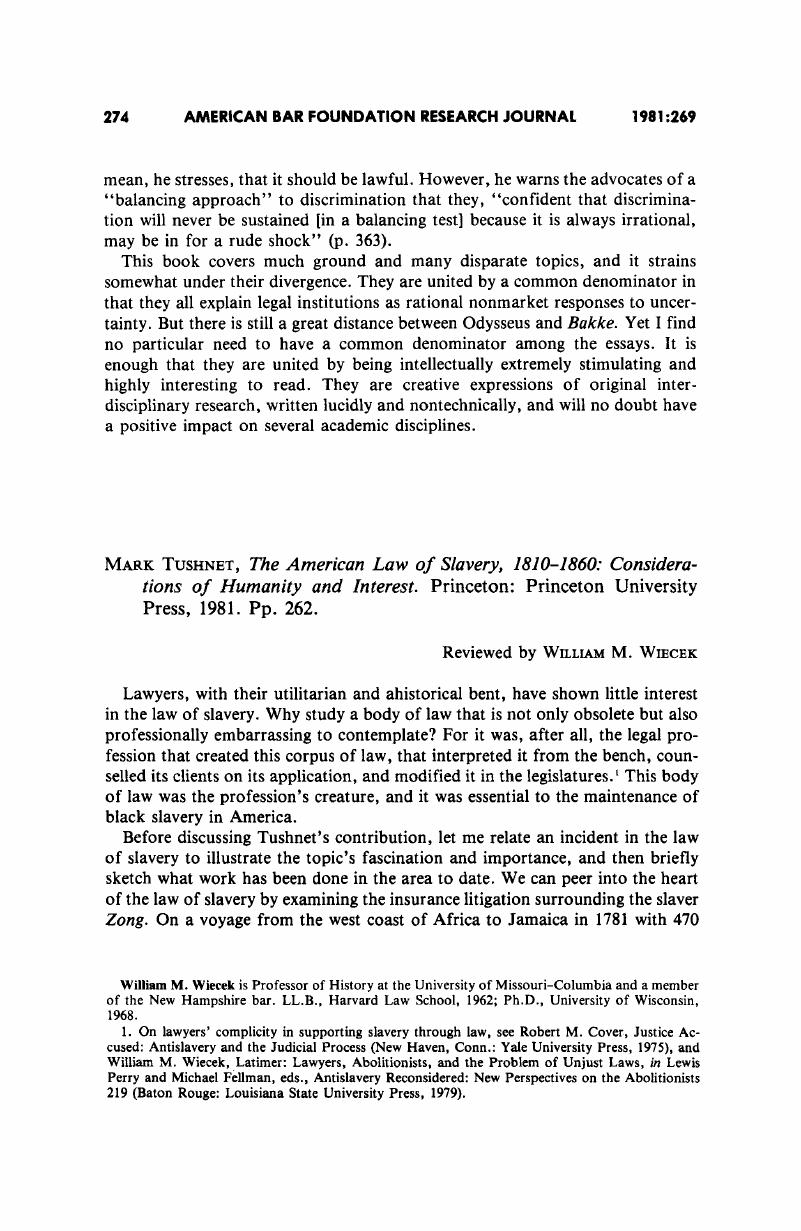No CrossRef data available.
Article contents
Mark Tushnet, The American Law of Slavery, 1810-1860: Considerations of Humanity and Interest. Princeton: Princeton University Press, 1981. Pp. 262.
Published online by Cambridge University Press: 20 November 2018
Abstract

- Type
- Book Reviews
- Information
- Copyright
- Copyright © American Bar Foundation, 1982
References
1. On lawyers' complicity in supporting slavery through law, see Robert M. Cover, Justice Accused: Antislavery and the Judicial Process (New Haven, Conn.: Yale University Press, 1975), and William M. Wiecek, Latimer: Lawyers, Abolitionists, and the Problem of Unjust Laws, in Lewis Perry and Michael Fellman, eds., Antislavery Reconsidered: New Perspectives on the Abolitionists 219 (Baton Rouge: Louisiana State University Press, 1979).Google Scholar
2. John Weskett, A Complete Digest of the Laws, Theory and Practice of Insurance 525 (London, 1781), quoted in F. O. Shyllon, Black Slaves in Britain 185 (London: Oxford University Press, 1974).Google Scholar
3. Gregson v. Gilbert, 3 Doug. 233, 99 Eng. Rep. 629 (K.B. 1783).Google Scholar
4. Lee's argument was recorded by an observer, the English abolitionist Granville Sharp, and was published in Prince Hoare, A Memoir of Granville Sharp, Esq. (1820), quoted in Shyllon, supra note 2, at 190 (emphasis in original).Google Scholar
5. In addition to the volume under review, see Mark Tushnet, The American Law of Slavery, 1810–1860: A Study in the Persistence of Legal Autonomy, 10 Law & Soc'y Rev. 119 (1975);id., Approaches to the Study of the Law of Slavery, 25 Civil War Hist. 329 (1979).Google Scholar
6. Nash, A. E. Keir, Fairness and Formalism in the Trials of Blacks in the State Supreme Courts of the Old South, 56 Va. L. Rev. 64 (1970);id., A More Equitable Past? Southern Supreme Courts and the Protection of the Antebellum Negro, 48 N.C.L. Rev. 197 (1970);id., Negro Rights, Unionism, and Greatness on the South Carolina Court of Appeals: The Extraordinary Chief Justice John Belton O'Neall, 21 S.C. L. Rev. 141 (1979);id., The Texas Supreme Court and Trial Rights of Blacks, 1845–1860, 58 J. Am. Hist. 622 (1971);Flanigan, Daniel J., Criminal Procedure in Slave Trials in the Antebellum South, 40 J.S. Hist. 537 (1974);Michael Stephen Hindus, Black Justice Under White Law: Criminal Prosecutions of Blacks in Antebellum South Carolina, 63 J. Am. Hist. 575 (1976);id., The Contours of Crime and Justice in Massachusetts and South Carolina, 1767–1878, 21 Am. J. Legal Hist. 212 (1977).Google Scholar
7. Arthur Howington, Not in the Condition of a Horse or an Ox: Ford v. Ford, The Law of Testamentary Manumission, and the Tennessee Court's Recognition of Slave Humanity, 34 Tenn. Hist. Q. 249 (1975).Google Scholar
8. A. L. Higginbotham, In the Matter of Color: Race and the American Legal Process: The Colonial Period (New York: Oxford University Press, 1980); Wiecek, William M., The Statutory Law of Slavery and Race in the Thirteen Mainland Colonies of British America, 34 Wm. & Mary Q. 258 (1977).Google Scholar
9. Nash, A. E. Keir, Reason of Slavery: Understanding the Judicial Role in the Peculiar Institution, 32 Vand. L. Rev. 7 (1979).Google Scholar
10. Helen Tunnicliff Catterall, ed., Judicial Cases Concerning American Slavery and the Negro (5 vols.) (Washington, D.C.: Carnegie Institute of Washington, 1926–37).Google Scholar
11. George M. Stroud, A Sketch of the Laws Relating to Slavery in the Several States of the United States of America (Philadelphia: Kimber & Sharpless, 1827; Philadelphia: Longstreth, 1856); William Goodell, American Slave Code in Theory and Practice: Its Distinctive Features Shown by Its Statutes, Judicial Decisions, and Illustrative Facts (New York: American and Foreign Anti-Slavery Society, 1853); Thomas R. R. Cobb, An Inquiry into the Law of Negro Slavery in the United States of America (Philadelphia: T. & J. W. Johnson & Co., 1858); John Codman Hurd, The Law of Freedom and Bondage in the United States (Boston: Little, Brown & Co., 1858, 1862); Jacob Wheeler, A Practical Treatise on the Law of Slavery. Being a Compilation of All the Decisions Made on That Subject, in the Several Courts of the United States (New York: A. Pollock, 1837). Cobb, unlike most other figures in the law of slavery, paid dearly for his beliefs. As a young Confederate brigadier, he was killed in action at Fredericksburg in 1862.Google Scholar
12. Stanley M. Elkins, Slavery: A Problem in American Institutional and Intellectual Life (3d ed. Chicago: University of Chicago Press, 1976); Eugene Genovese, The World the Slaveholders Made (New York: Pantheon, 1969); id., Roll, Jordan, Roll: The World the Slaves Made (New York: Random House, 1976).Google Scholar
13. 13 N.C. (2 Dev.) 263 (1829).Google Scholar
14. Daniel J. Boorstin, The Americans: The National Experience 444 (New York: Random House, 1965).Google Scholar
15. Scheiber, Harry N., American Constitutional History and the New Legal History: Complementary Themes in Two Modes, 68 J. Am. Hist. 337, 349 (1981); Laurence Tribe, American Constitutional Law (Mineola, N.Y.: Foundation Press, 1978).Google Scholar
16. Cf. the presumption “in favour of liberty” in an earlier Mississippi case (one much cited by abolitionists), Harry v. Decker & Hopkins, 1 Miss. Walker 36, 43 (1919).Google Scholar
17. I have argued this point at greater length in William M. Wiecek, The Sources of Antislavery Constitutionalism in America, 1760–1848, at ch. 6, The Southern Counteroffensive (Ithaca, N.Y.: Cornell University Press, 1977).Google Scholar
18. 1822 S.C. Acts 1822. This statute provided that any free black seaman debarking from his vessel while in Carolina waters was to be jailed; if the vessel's master failed to pay the seaman's fine before the vessel sailed, the seaman was to be sold into slavery.Google Scholar
19. Elkison v. Deliesseline, 8 F. Cas. 493 (C.C.D.S.C. 1823) (No. 4366). Cf. Johnson's concurrence in Gibbons v. Ogden, 22 U.S. (9 Wheat) 1 (1824) (Johnson, J., concurring, at 27–33).Google Scholar
20. William Wirt's opinion, not officially printed, may be found in Free Colored Seamen—Majority and Minority Reports, H.R. Rep. Doc. No. 80, Ser. 426, 27 Cong., 3d Sess. (1843).Google Scholar


